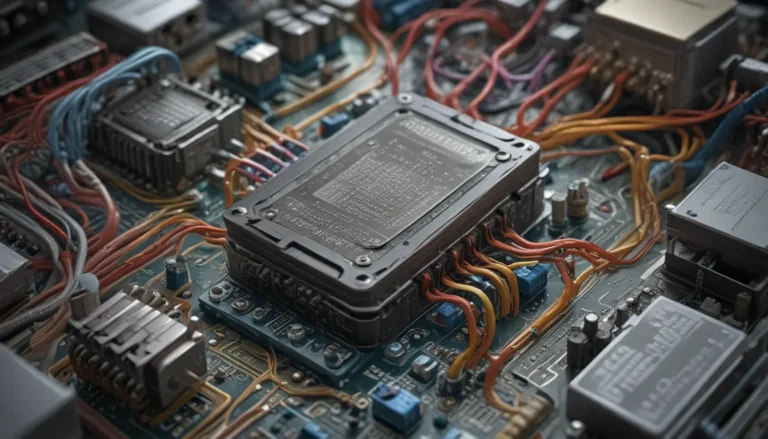A Note About Images: The images used in our articles are for illustration purposes only and may not exactly match the content. They are meant to engage readers, but the text should be relied upon for accurate information.
In the realm of physics, certain discoveries stand out for their profound impact on technology and scientific research. One such invention is the Josephson Junction, named after physicist Brian D. Josephson, which has revolutionized the field of superconductivity since its development in 1962. From quantum computing to medical imaging, the Josephson Junction plays a pivotal role in various applications, driving advancements in science and technology. Let’s explore 12 intriguing facts about this remarkable device that showcase its significance and potential.
The Discovery and Nobel Prize Win
The Josephson Junction sprung from the innovative mind of physicist Brian D. Josephson in 1962. This groundbreaking device allows current to flow between superconductors without voltage, leading to a Nobel Prize in Physics for Josephson in 1973. It remains a cornerstone in the study of superconductivity and quantum phenomena.
Quantum Tunneling Phenomenon Unveiled
Central to the operation of the Josephson Junction is the phenomenon of quantum tunneling. Electrons can traverse an insulating barrier without resistance, characteristic of this device. The delicate interplay between superconductors and insulators enables the remarkable performance of Josephson Junctions.
Quantum Computing Advancements
Josephson Junctions are indispensable in the realm of quantum computing due to their high sensitivity to magnetic fields. These devices encode and process qubits – the fundamental units of quantum information – paving the way for cutting-edge technologies that revolutionize computation and encryption.
Precision Voltage Measurements with SQUIDs
Superconducting Quantum Interference Devices (SQUIDs) leverage Josephson Junctions to detect minuscule changes in voltage and magnetic fields. This precision allows for applications in scientific research, medical diagnostics, and other fields where ultra-sensitivity is paramount.
Unveiling the Josephson Effect
At the core of Josephson Junctions lies the Josephson effect, enabling the generation of alternating current without applied voltage. This unique behavior underpins precision measurements and scientific instrumentation, showcasing the device’s versatility and utility.
Lightning-Fast Switching Speeds
Josephson Junctions boast an exceptional switching speed, transitioning between conducting and non-conducting states in mere picoseconds. This rapid response makes them ideal for high-speed digital circuits and signal processing applications, pushing the boundaries of technological innovation.
Exploring Flux Flow Oscillations
Under specific conditions, Josephson Junctions exhibit flux flow oscillations, stemming from quantized magnetic flux quanta movement. Scientists study these oscillations for potential use in high-frequency oscillators, unlocking novel possibilities for advanced electronics and communication systems.
Operating at Cryogenic Temperatures
To achieve superconductivity, Josephson Junctions necessitate extremely low temperatures nearing absolute zero. Cryogenic cooling techniques enable these devices to manifest their unique properties, setting the stage for breakthroughs in quantum computation and sensitive measurements.
The “Voltage Standard” Moniker
Recognized as the “Voltage Standard,” Josephson Junctions offer unparalleled voltage-frequency relationships, ideal for high-precision metrology and calibration applications. Their precision and accuracy make them indispensable tools for ensuring standards compliance across various industries.
Vital Role in Medical Imaging
Josephson Junctions play a critical role in magnetoencephalography (MEG) by capturing magnetic fields generated by the brain without invasion. This non-invasive technique supports neuroscience research and aids in diagnosing neurological conditions, highlighting the device’s diverse applications.
Supporting Particle Physics Experiments
In the realm of particle physics, Josephson Junctions are instrumental in detecting and measuring subatomic particle energies. By capturing minute electrical signals, scientists gain insights into the fundamental particles and forces shaping our universe, broadening our understanding of the cosmos.
Josephson Voltage Standard Array Innovation
The assembly of Josephson Junctions into arrays forms a Josephson Voltage Standard (JVS), providing a stable source of precise voltage. These arrays find utility across scientific, industrial, and metrological applications, underscoring the versatility and reliability of Josephson Junctions.
Delve Deeper into the Quantum World
The enigmatic world of Josephson Junctions offers a glimpse into the intricate interplay between quantum mechanics and superconductivity. By understanding these 12 intriguing facts, we uncover the vast potential and promise of Josephson Junctions in shaping the future of technology and physics exploration. From quantum computing to medical diagnostics, these devices continue to push the boundaries of what is possible in the realm of science and innovation.
Embrace the wonders of Physics
Embark on a journey through the captivating landscape of superconductivity and quantum phenomena. Dive into the fascinating realm of quantum entanglement and its implications for quantum computing. Explore the remarkable life and contributions of Pyotr Kapitsa, a trailblazing scientist in cryogenics. Each topic promises to ignite your curiosity and deepen your appreciation for the complexities of the universe.
Your Trustworthy Source for Engaging Content
At our core, we strive to provide you with accurate and engaging content that sparks curiosity and fosters learning. Every fact shared on our platform is contributed by individuals like you, enriching our community with diverse insights and information. Our dedicated team of editors ensures the highest standards of accuracy and reliability, guaranteeing that the facts you encounter are not only fascinating but also authentic. Trust in our commitment to quality and authenticity as you embark on a journey of discovery and exploration with us.
FAQs
-
What is a Josephson junction?
A Josephson junction is a superconducting electronic device enabling current flow between superconductors without applied voltage. -
What is the Josephson effect?
The Josephson effect allows electrical current to traverse the insulating barrier in a Josephson junction without voltage, leading to coherent superconducting wavefunction oscillations. -
Where are Josephson junctions used?
Josephson junctions find applications in digital circuits, quantum computing, ultra-sensitive detectors, and magnetic resonance imaging systems, among others. -
How do Josephson junctions contribute to quantum computing?
Josephson junctions serve as essential components in superconducting qubits, facilitating quantum information processing and operations. -
Why are Josephson junctions crucial in medical imaging?
Josephson junctions play a key role in superconducting magnets for magnetic resonance imaging (MRI) systems, aiding in non-invasive diagnostics and research. -
Are there practical challenges in using Josephson junctions?
Maintaining stable operation at ultra-low temperatures near absolute zero poses a challenge for Josephson junctions, necessitating advanced cryogenic techniques. -
Can Josephson Junctions aid in teleportation?
No, Josephson Junctions manipulate quantum information but cannot facilitate teleportation, emphasizing their role in quantum information processing and scientific exploration.
Unravel the mysteries of Josephson Junctions as you embark on a journey through the captivating world of quantum phenomena and superconductivity. Explore the endless possibilities and applications of these remarkable devices, and witness firsthand the profound impact they have on shaping the future of technology and scientific inquiry.






